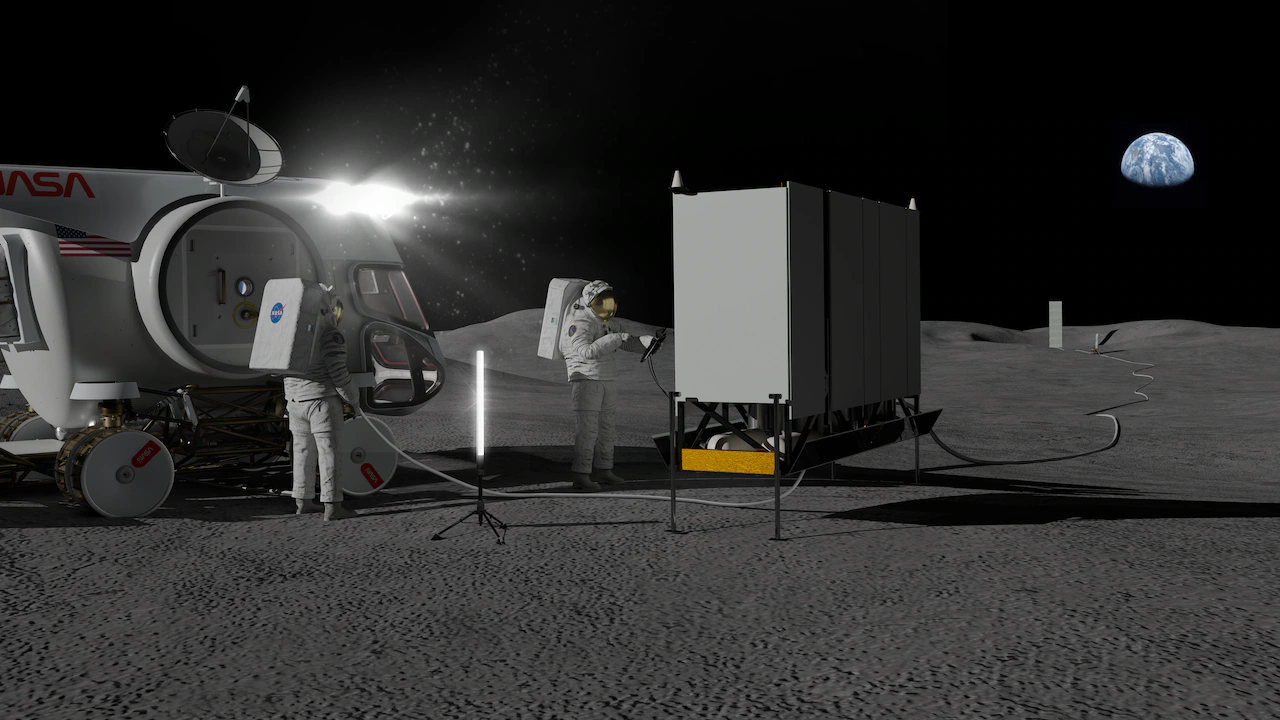
CLEVELAND, Ohio – Cleveland’s NASA Glenn Research Center is spearheading an ambitious project that sounds like something out of science fiction: building a nuclear power plant on the moon by 2030.
The project’s urgency stems from a race with global rivals to claim prime lunar real estate for permanent bases to be used for scientific research, resource extraction, military strategy, and launching missions to Mars, asteroids and deep space.
At an August press conference, U.S. Transportation Secretary Sean Duffy declared that the United States is in “a race with China to the moon.”
“To have a base on the moon, we need energy,” continued Duffy, who is the National Aeronautics and Space Administration’s acting administrator. “If we’re going to be able to sustain life on the moon to then go to Mars, this technology is critically important.”
Duffy said a moon base would need both solar power and nuclear fission. Using technology overseen by NASA Glenn, the agency plans to build a 100-kilowatt plant on the moon that would use nuclear fission to produce roughly the same amount of energy that a 2,000 square foot home uses every 3 1/2 days.
Duffy said NASA’s Artemis mission will involve successive astronaut trips to the moon that will eventually involve shipping raw materials to the moon where astronauts will build a base.
“There’s a certain part of the moon that everyone knows is the best,” Duffy said. “We have ice there. We have sunlight there. We want to get there first and claim that for America. And to do this … the fission technology is critically important to sustain life.”
Nuclear in space
NASA officials say nuclear power plants that work in space will be vital for any sustained presence on the moon and Mars, as they can provide continuous and abundant power, regardless of sunlight or temperature. Fission power systems can operate in permanently shadowed areas and during lunar nights – which last 14 1/2 Earth days – or throughout lengthy Martian dust storms.
Duffy issued a directive in August calling on the space agency to fast-track development of fission surface power technology to support America’s return to the moon and eventual missions to Mars.
“Since March 2024, China and Russia have announced on at least three occasions a joint effort to place a reactor on the Moon by the mid-2030s,” the directive says. “The first country to do so could potentially declare a keep-out zone which would significantly inhibit the United States from establishing a planned Artemis presence if not there first.”
The directive said that NASA would designate a Fission Surface Power Program Executive – who will seek proposals from private industry for the project. It picked Glenn Research Center’s Steven Sinacore for the job, with Lindsay Kaldon named deputy program executive. Sinacore said there was no competition between Glenn and other NASA centers for the work.
“Glenn was a natural choice to lead the effort because of the center’s expertise and experience in space power,” Sinacore explained in a written response to questions from The Plain Dealer. “Glenn has been managing the development and demonstration of a smaller, lower power fission system for several years,” which Kaldon managed.
When combined with solar cells, batteries, and fuel cells, fission systems can support rover operations, scientific experiments, and in-situ resource utilization — producing water, propellant, and other essential supplies for human exploration, Sinacore says. A fission power system also could be used on most planetary surfaces with little or no change in overall system design.
He says the power system development is funded by NASA’s Exploration Systems Development Mission Directorate Moon to Mars Program, which will allocate funds to the center to award contracts to companies who will develop, deploy, and operate the power system on the lunar surface.
When asked if the project would provide a budget windfall for Glenn, Sinacore said fission surface power “is a priority for NASA, and the agency is working with stakeholders to ensure the program’s budget is appropriate to accomplish the FSP directive objectives.”
Sinacore says the nuclear power system would be built and assembled on Earth. It won’t be activated until it reaches the surface of a moon or planet, and would be dormant during launch and transit.
The technology could power everything from scientific experiments to the production of water, fuel, and other essentials for human exploration—a process called in-situ resource utilization that would be crucial for establishing a sustainable lunar presence.
A manufacturing moonshot
The project has generated excitement beyond NASA’s walls, particularly among manufacturers and technology companies who want to bid on the project, and those who see potential spinoffs for Earth-based applications.
Ethan Karp of MAGNET, a Cleveland organization that supports regional manufacturing, emceed a panel discussion about the fission surface power initiative during a recent Ohio Space Forum.
The panel featured Sinacore alongside representatives from four companies positioning themselves to bid on future contracts, including BWX Technologies – which has a Cleveland presence – and nuclear industry veteran Westinghouse.
What emerged from the discussion, according to Karp, was that the fundamental nuclear technologies already exist—NASA has been using nuclear power in space for 60 years and has flown radioisotope power systems on 27 missions. The challenge now is integration and reliability.
“We know we can do it, what we don’t have necessarily, are all the systems integrated for the efficiency and reliability that we would need to have something, for example, run for 10 years on the moon,” Karp explained.
For the Cleveland region, the project represents what Karp calls “a literal manufacturing moonshot.” While the immediate manufacturing benefits may be limited to specialized companies like BWX Technologies, he sees longer-term implications for the entire regional economy.
“The idea that we’re setting this broad vision for a manufactured product that could fundamentally shape how we do energy, and how all of the companies in our energy supply chains think about what they’re producing 10, 20, 30 years from now,” Karp said. “And knowing that that is happening at Glenn, that is happening right here, that is a very exciting thing.”



